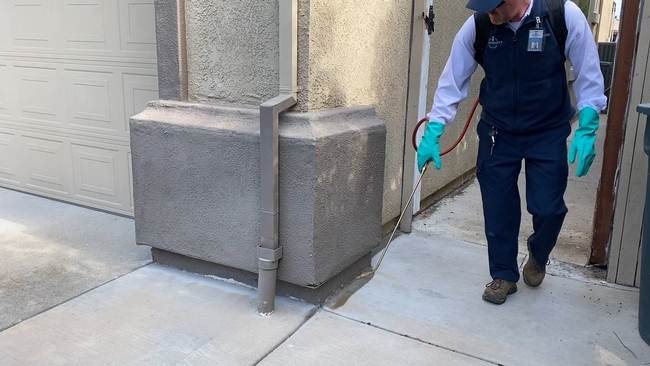Licensing for perimeter spraying under California's pest control laws is dependent on the situation and site (Table 1). Structural Pest Control Board (SPCB) licensees, Department of Pesticide Regulation (DPR) Qualified Applicator License (QAL) holders, and DPR Qualified Applicator Certificate (QAC) holders are all legally allowed to make perimeter spray applications to control ants and other pests immediately around structures. However, the intent of these applications determines the specific license needed.

SPCB licenses
If the perimeter spraying is performed to prevent the entry of ants or other insects into the structure, then a structural license is required. If the pests are coming from the lawn, then the lawn is considered as a “pest reservoir” and can be treated by the Branch 2 licensee.
DPR licenses
It is important to know what DPR license type allows the applicator to perform perimeter sprays.
- QAL holders with Category A (Residential, Industrial, and Institutional) can do perimeter treatments for ants or other pests that occur indoors and near the structure. QAL Category A licensees, however, cannot provide commercial service to customers (for hire). This license category is most common for governmental employees or institutional employees who perform in-house pest control services as part of their job.
- QAL holders with Category B (Landscape Maintenance) can do perimeter sprays as part of their landscape management efforts. For instance, if landscape shrubs get infested by aphids and tended by ants, then treatment of those plants and perimeter spraying, which incidentally prevents an ant invasion to the structure, is permitted.
- QAC, subcategory Q (Maintenance Gardeners) are also permitted to do perimeter sprays when the application is made as an incidental part of their maintenance gardening work.
It is wise for any pesticide applicator to make sure they are applying pesticides in the right place, at the right time, and for the right reason. Such forethought helps reduce environmental contamination and helps applicators avoid regulatory violations and their consequences.
|
Site/ Situation |
License Required |
Section Cited |
Description of Pest Control Conducted |
|
Adjacent to structure, garden, or orchard pest |
QAL Cat A, Cat B or QAC Subcat Q |
FAC §§ 11701 or 11704 |
Control (for the purpose of eliminating ants, earwigs, garden or non-crop orchard pests, or to assist in the control of honeydew producing insects) even where treatment is applied adjacent to a structure and incidentally prevents invasion of the structure. |
|
Landscape plants & turf |
QAL Cat B or QAC Subcat Q |
FAC §§ 11701 or 11704 |
Any application of a pesticide to existing landscape plants & turf, irrespective of their location in respect to a structure, except for incidental contact of foliage or plants with a pesticide arising from structural pest control activities. Any pesticide application made directly to interiorscapes in business buildings, office complexes, malls, houseplants within households. |
|
Structures, interior or exterior |
Structural |
B&PC § 8550 |
Control of ants, earwigs, cockroaches, silverfish, termites, birds, or rodents invading structures is strictly structural pest control, whether carried on within or outside of the structure. |
|
Structures, in or around |
Structural Branch 2 |
B&PC § 8550 |
Control of pests to humans and their pets, (it would apply to pests other than fleas, for example, mosquitoes) in or around a structure, including treatment of outside areas to control nearby nest or pest reservoir. |
[Originally featured in the Fall 2021 edition of the Green Bulletin Newsletter for structural and landscape pest professionals.]
Disclaimer: Readers should get the most updated regulatory information from federal, state, county, and city resources. Remember, laws change all the time!
Reference: PUE Program Standards Compendium Volume 1: General Administration of the Pesticide Use Enforcement Program – Section 10: Quick Reference Charts. cdpr.ca.gov/docs/enforce/compend/vol_1/entirerep.pdf